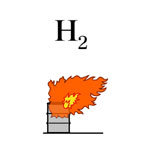| Case Name |
Fire caused due to damaged glass of a level gauge at a hydrogen sulfide absorption column of a kerosene hydrodesulfurization unit |
| Pictograph |

|
| Date |
October 26, 1973 |
| Place |
Kawasaki, Kanagawa, Japan |
| Location |
Chemical factory |
| Overview |
At a hydrogen sulfide absorption column of a desulphurization plant, hydrogen gas spouted out from the level gauge and caused a fire. Irregular insertion of the gasket into the sealed glass of the level gauge and a flange of the level gauge loosened the bolt and caused leakage. The glass was destroyed. Review and listing of inspection points, improvement of facilities and shortening of the inspection cycle were carried out. |
| Incident |
A fire broke out at the hydrogen sulfide absorption column, which removes hydrogen sulfide from the circulating hydrogen at the kerosene desulphurization plant with ADIP aqueous solution, when hydrogen gas spouted out from the Klinger level gauge at the bottom of the column. Operating temperature: 40 °C, operation pressure: 5 MPaG.
ADIP: Amine di-isopropanol |
| Processing |
Manufacture |
| Individual Process |
Separation |
| Substance |
Hydrogen, Fig2 |
| Type of Accident |
Leakage, fire |
| Sequence |
On October 25th, 1973: The plant stopped for the turnaround shutdown maintenance. Only the hydrogen sulfide absorption column, which caused the accident, continued operation.
About 12:55 on October 26th: A construction staff found the fire on hearing a loud noise, and reported it from the control room.
12:55: The chief who confirmed the fire directed emergency shutdown.
About 13:01: The emergency shutdown operation started in the control room.
13:10: After separating the burning column from other equipment, the emergency dump valve was released, and the tower pressure dropped from 5.0 MPa to 0.5 MPaG. Water was sprayed and injected into the column until the water level reached above the leakage point.
13:25: The fire was extinguished. |
| Cause |
The packing that sealed the glass of the Klinger level gauge in the main body had deteriorated due to irregular insertion and excessive tightening. This deterioration caused slackness of a bolt without a spring washer and its surrounding bolts during the two-year operation period. It was assumed that the leakage started around the bolt without a spring washer, increased internal pressure, and the gasket was cut off at the bolts next to the leakage bolt, which caused spouting of process gas. Static electricity generated at the spouting gas is considered to be the ignition source. |
| Response |
Emergency shutdown work. Spraying water for cooling. Stopping gas leakage by raising water level at the bottom of the column. |
| Countermeasures |
A differential pressure-type level gauge is used under severe operating conditions in terms of temperature and pressure, and an automatic stop valve was installed in all other level gauges. The inspection cycle was determined to be four months. The maintenance management manual was reviewed to list points that were previously overlooked.
The type of a block valve was changed. |
| Knowledge Comment |
Excessive dependence on past experience can lead to misjudgments on safety, reliability, and life spans of facilities or equipment.
If more advanced components than those already installed such as block valves in this case are available in the market, replacement should be considered. |
| Background |
1. The manufacturer has to take major responsibility because the accident took place within the level gauge's stipulated ten-year life. It is also a serious problem that the defect could not be detected on delivery.
2. Precursory phenomenon might be overlooked at inspection during operation. Considering that the level gauge rarely causes problems based on the former experience, inspection might become routine.
3. Two block valves at the top and bottom of the level gauge aggravated the damage. Valves with the function of automatically cutting off the flow when a large leakage occurs should have been adopted. A mistake in selection at purchase and a lack of follow-up afterwards are also to be blamed. |
| Incidental Discussion |
Damage to the glass of the level gauge is not unusual. In particular, it is easily damaged at high temperatures due to differences in thermal expansion between glass and metal. |
| Reason for Adding to DB |
Example of accident showing the importance of inspections and maintenance of a plant |
| Scenario |
| Primary Scenario
|
Poor Value Perception, Poor Safety Awareness, Inadequate Risk Recognition, Organizational Problems, Inflexible Management Structure, Maintenance Based on the Experience only, Carelessness, Insufficient Precaution, Inadequate Inspection, Planning and Design, Poor Planning, Selection Mis of Parts, Failure, Fracture/Damage, Crack of Glass, Secondary Damage, External Damage, Fire
|
|
| Sources |
The Kawasaki City Complex Safety Countermeasure Committee, Investigation report on the causes of fire at hydrodesulfurization equipment in K factory, T petroleum Co., Ltd.(1974).
High Pressure Gas Safety Inst. of Japan Kawasaki and Yokohama complex protection research report. pp.84-85(1983).
Chemical Industries Association. The accident disaster case. Towers and Vessels. Accident disaster case and countermeasures. Safety countermeasure technology for chemical plant 4. pp.197-198(1979).
|
| Physical Damage |
About 20 cubic meters of process gas consisting of 95% hydrogen and 5% methane burned. A level gauge and some instruments were partially damaged by the fire. Some parts of two towers scorched. |
| Financial Cost |
¥ 110,000 (Investigation report on the causes of fire at a hydrodesulfurization unit at K factory) |
| Multimedia Files |
Fig2.Chemical formula
|
| Field |
Chemicals and Plants
|
| Author |
WAKAKURA, Masahide (Kanagawa Industrial Technology Research Institute)
TAMURA, Masamitsu (Center for Risk Management and Safety Sciences, Yokohama National University)
|